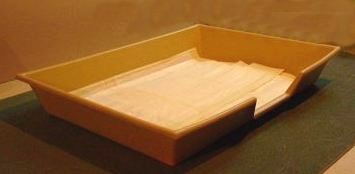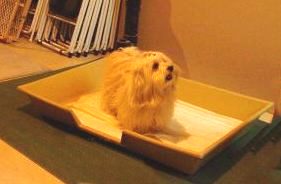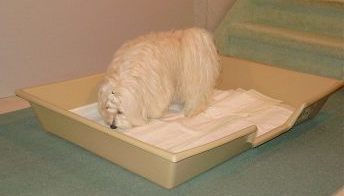Housebreaking your Havanese
Havanese, like many toy breeds, may tend to be a bit slower to housebreak. This does not mean difficult or impossible, just that the process may take more time. Consistency is the key. On average, Most Havanese are reliable by 6-7 months of age. There are many different ways to house train your puppy. Bell training is a popular method among Havanese owners.
If you would like to bell train your Havanese; first choose a bell to use. My choice is a few small bells tied onto a long cord with a loop on the end hung next to the door. Other choices are medium bells on a ribbon or strap or small chimes. The bells should be hung by the door at the dogs nose level. For doors where you can't hang bells ( ie: sliding glass doors) other options are desk bells or buzzers or an actual door bell on the floor - battery operated or permanently wired. Hanging bells are usually rung with the nose while floor bells are usually rung with the paw. Most bells are very portable and easy to take along when travelling or visiting.
NOTE OF CAUTION - When choosing a bell for a
Havanese or other small dog, be sure to
choose an open style cow bell (as in the photo) rather than a closed round style jingle bell. A small dog
can all too easily get a claw caught in a round bell if they ring with a paw. An open bell will be
safest. If you do choose to use round bells you may wish to enclose them in a small bag for
additional protection. Chimes are another option.
After choosing your bell, the next step is to teach your Havanese what the bells mean. There are at least three ways to go about it. With puppies, a good way is to set up your bells by the door and every time you go out with the puppy you ring the bells. Gently bump the bell with the puppy's nose or paw. If you are really in a rush, just ring the bell with your foot on the way by. In no time at all, your Havanese puppy will learn to associate the sound with the door opening and going outside. And then one day, they ring it themselves and you reinforce the behaviour from there. Puppies are great as you take them out so often.
A 2nd method is to start by teaching your Havanese to ring
a bell as a trick. Hold the bell in
front of their nose. Most dogs will bump it to see what it is. Praise and reward. Then do it again
a few more times. They will start to ring the bell. Do this several times over a day or two, and
soon your Havanese will be doing it on command. If your Havanese already knows the
command "touch" it will be even easier. Once your Havanese is ringing the bell on command,
next, place the bell at the door and ask them to ring it before you let them out. They will quickly
understand what you want them to do.
A 3rd method is the lazy way and involves very little effort on your part. All it requires is an already bell trained dog. The experienced dog does all the training by example. As they ring the bell to go out, the younger puppy or new dog quickly learns to follow and then starts to run to the door each time it rings. Eventually they also start ringing it themselves. This method can be reinforced by the two first methods to make it go even faster but it does work all on its own.
At some point in the bell training, your Havanese will clue in as to what the bell means. At this point, your puppy may ring the bell incessantly. This is when the behaviour is being locked in and so it's important that you let your puppy out each and every time, no matter how annoying the frequency may be. Soon he will ring the bell only to go out. Note that may not only be if your puppy needs to go potty, he may also ring to ask to go out to investigate a sound, or to go play or just to go outside. Housebreaking your Havanese need not be an exercise in frustration. Bell training is just one method you can use. Give it a try, and see.
Litter training
Toilet training your Havanese is any training which teaches your pet to keep your house clean and to eliminate in an appropriate area. For some people, conventional housebreaking is not the best option. Litter box training may be a practical alternative for a number of situations including apartment/condominium dwellers, senior citizens and people who travel extensively with their dog.
My friend , Susanne Slaney shares her experience with litter training her Havanese.
Havanese are versatile little dogs who adapt easily to many different lifestyles and are just as suitable for apartment/condo dwellers as they are for urban houses or rural environments. As a family living in a condo, we chose litter box training our Havanese for many reasons. We work full time and wanted our Havanese to be able to relieve themselves anytime without having to wait till we get home. The use of a litter box has the added benefit of saving our yard from the dead grass spots common to dog owners' yards. As Condo dwellers, we share a common yard with our neighbours. The dogs may not go out on their own and must always be accompanied, which can be awkward and inconvenient at times. We especially appreciate the indoor facilities in inclement weather and during our harsh prairie winters.
Litter box training is easily accomplished. Litter pans are readily available at pet supply stores in assorted sizes and materials. We chose a large moulded plastic pan as it is sturdy and easy to clean. Dog pans are quite a bit larger than cat pans; don't pick one which is too small.
You will also need disposable absorbent material to line your pan. There are several types of dog litter and liners available. What works best for us are disposable hospital absorbent pads (available from medical supply houses). These pads remain neatly in the litter box and are easily folded and discarded in a trash bag. The pads also allow faeces to be removed with toilet paper and flushed in the toilet rather than "scooping". Absorbent pads are "travel friendly"and can easily be used in airports, hotels or anywhere that outdoor access is not readily available. Enzyme treated pads are unnecessary and also rather expensive long term though they may be useful for the initial training of young puppies. Another option is to put a piece of sod in the litter pan so your Havanese has grass to eliminate on, either indoors or on a balcony. Sod must be watered regularly and changed every few months. Pellets/litter are available but perhaps not the best option for Havanese except as young puppies. The long luscious Havanese coat picks up an amazing amount of debris which you will then find scattered throughout your home, meaning extra housekeeping and grooming time. Some people choose newspaper to line the litter box. While useful in an emergency, newspaper is less than ideal as it is not especially absorbent, can be quite messy with the added problem of ink transfer to the dogs' coat. Another issue is that your dog may then view any newspaper left laying around anywhere as a potential toilet.



When litter box training your Havanese; location is very important. Choose a spot which is readily accessible to your Havanese but out of traffic areas and well removed from sleeping and eating areas. The litter box training method is the same as any other; take your Havanese to the litter box frequently then praise and reward for eliminating in the right place. Litter box training in no way discourages the Havanese from eliminating outdoors. When on an outing, they will detect smells and eliminate instinctively. In fact, most will prefer to potty outside when possible.